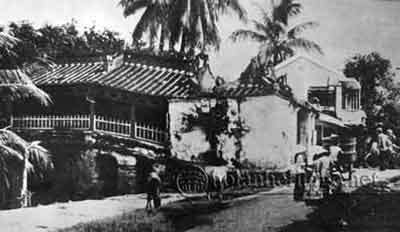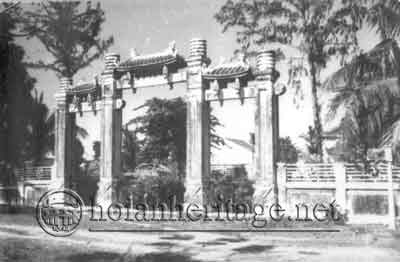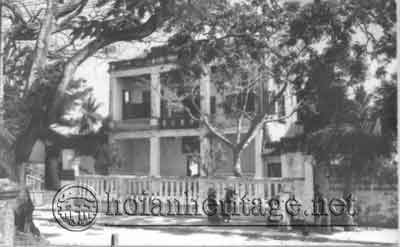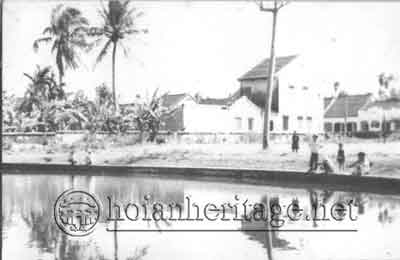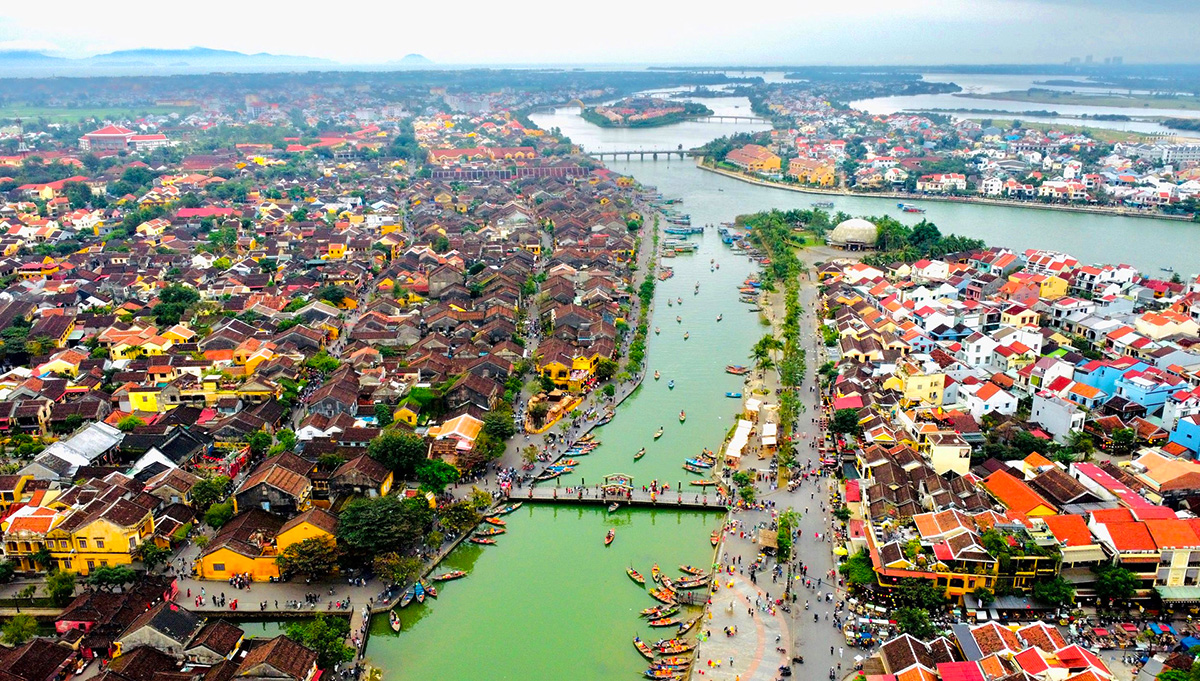Hoi An World Cultural Heritage Conservation Center
TANGIBLE CULTURAL HERITAGE
Located in a field next to the mountain of Bai Lang on Hon Lao Island, the archaeological site was discovered in May 1999 and excavated in June 2000 (total area of 21 square meters). Artifacts from this site consist of raw pottery (terracotta pottery) and especially stone artifacts, sharpened stone tools such as: short quadrilateral shaped axes, shouldered axes, scraping blades, many kinds of graters. Pebble tools include: pestles, grinders, pottery tools, fishing net weight,… and many other artifacts such as: fish teeth, bone needles, pieces of mollusc, plant seeds, charcoal,… These artifacts were found in a stable cultural layer with a thickness of 60 centimeters. And the upper cultural layer contained: ceramics, terracotta, raw pottery which date from the 9th-10th century and afterwards. Through these artifacts, strata structures, cultural layers and by using carbon fourteen dating, scientists have affirmed that this site was the relic of indigenous people in Prehistoric Times over 3000 years ago. This relic was recognized as a National Relic by Ministry of Culture and Information on 13 December 2006 in accordance with Decision No.96/2006/QĐ-BVHTT.



Located in Bai Lang Village, Bai Lang habitation site was explored in 1998 and excavated in May 1999 (total area of 8 square meters). Many pottery, ceramic, terracotta artifacts from Champa, China, Near Middle East were found at this archeological site along with some glass, stone, agate jewellery. There are many traces of domestic glass production by Champa inhabitants in Bai Lang. Geographical location of these artifacts and some historical documents show that this was the stopping place and commercial exchange of international merchants in Champa Period from 7th century to 10th century AD. This relic was recognized as a National Relic by Ministry of Culture and Information on 13 December 2006 in accordance with Decision No.96/2006/QĐ-BVHTT.


3/ THE OLD SHIPWRECK EXCAVATION IN THE SEA OF THE CHAM ISLANDS
This was the first major underwater archaeological excavation in Viet Nam. 150 persons from 13 countries including Vietnam, Malaysia, England, Singapore, Indonesia, Philippines… took part. Within five years (1996-2000), the underwater archaeologists carried out three surveys, three archaeological excavations and technical treatments, and retrieved 240.000 artifacts of many kinds of materials including ceramic, metal… The shipwreck location is from 16000’ to 16008’N latitude and from 108027’ to 108032’E longitude, 72 meters in depth, 15 kilometers north from the Cham Islands. It was located under 3 meters of sand dunes, the bow faced the east. This ship was made of Teak wood in Thailand in the early of 15th century. It has a length of 29,4 meters, a beam of 7,2 meters and divides into 19 holds which contained about 400.000 potteries of Chu Dau, My Xa (Hai Duong province), the Le Dynasty (the middle of the 15th century). The ship was wrecked in June – July due to the heavy load and typhoon. Based on Anthropology determinations of human skull, scientists informed that the owner of the ship is Thailand people. The old shipwreck excavation has helped us to understand more about “the silk road by sea” in Viet Nam, Vietnamese ceramic history and our country’s culture, economy, society, fine art culture in the 15th century.


4/ THE TIEN HIEN COMMUNAL HOUSE
Located at Giua Hamlet in Bai Lang Village, this communal house was built at the end of 18th century to worship the founders of the village on the Cham Island, along with the tutelary Gods for people in their daily lives. It is constructed in a domed style with ying – yang tiled roof, decorated with many themes such as “Lưỡng Long Tranh Châu” (Two dragons catching a pearl). The gable is gentle with the ends decorated with flowers, fish tails and dragon’s faces. The wide interior is divided into many compartments by the brick columns. The main altar of the main compartment has three tablets inscribed the names “Phục Ba Tướng Quân” and the gods of fishings. According to historical documents, “Phục Ba Tướng Quân” is a title conferred by the king on the generals who were good at controlling the big waves. The communal house has provided much valuable information about the settlement process and the religious customs of the Cham Islands’ inhabitants in the past. This relic was recognized as a National Relic by Ministry of Culture and Information on 13 December 2006 in accordance with Decision No.96/2006/QĐ-BVHTT.
5/ THE DAI CAN COMMUNAL HOUSE
Located at Giua Hamlet in Bai Lang Village, the Dai Can communal house was built in 18th century to worship the gods “Đại Càn Quốc gia Nam Hải”, “Nam Hải Cự tộc Ngọc Lân”, the ancestors and Ngu Hanh Fairy. Due to many storms and wars, the Dai Can communal house is now completely collapsed. The remains are the foundation, the “opening book” shaped screen, a manifesting column, especially a stele inscribed with the date of the 22nd year of Canh Hung's reign (1761). The inscriptions are faded but based on folk memory. The communal house was built for the religious needs of the Cham Islands’ inhabitants, and reflected the changes of the community organization in each historical period. This relic has provided much valuable information about the history of community and the coastal religious culture of the Cham Islands.

Located at Dong Chua in Bai Lang Village, the Hai Tang pagoda is a quite large religious architectural structure for worshipping Buddha and Saints to meet the religious need of the island’s inhabitants and is the stopping place of foreign trade boats. The pagoda was built in the 19th year of Canh Hung's reign (1758) about 200 meters northeast from its present location. After it was badly damaged by storms, in the first year of Tu Duc’s reign (1848), it was moved to the present location.
The main building has trusses in the “Vài trính Chồng – Trụ đội” (one of the traditional structures of Hoi An wooden monuments), and divides into three compartments. On the veranda, the ends of the rafters are decorated with very well carved wooden lantern, head of dragon, lotus.
The pagoda has provided much information about many fields of science, the formation of Buddhism of the island and is also an interesting place to visit. This relic was recognized as a National Relic by Ministry of Culture and Information on 13 December 2006 in accordance with Decision No.96/2006/QĐ-BVHTT.

The Cham Islands’ people worship “Ca Ong” (the Whale) with a respectful and grateful spirit because they have said from generation to generation that “Ca Ong” always helps them when they face risks at sea. The feudal government nominated “Ca Ong” many times and conferred fine names with honour, and established temples, and granted heritage-land to take advantage of fishermen’s worship. Located in the middle of a residential area at Dinh Hamlet in Bai Lang, the temple was built at the end of the 19th century following traditional style with low arches and its back has a main hall. The roof is covered with ying – yang tiled roof. The ridge and the gable are decorated with the four mystical creatures, dragon, unicorn, tortoise and phoenix. At the front of the temple, there is a “opening book” shaped screen of “Thần Ngư Hí Nguyệt” (Fish plays the moon). The interior consists of three compartments. The middle one where the Ca Ong’s bones are kept having a door to the back of the temple and in front of it, is a brick altar. Two other parts are the worshipping space of Gods.
This site not only reflects the religion of the fishermen but also shows the cultural variety of the Cham Islands’ people. This relic was recognized as a National Relic by Ministry of Culture and Information on 13 December 2006 in accordance with Decision No.96/2006/QĐ-BVHTT.

8/ THE BIRD NEST GATHERERS ANCESTRAL TEMPLE
Located in Bai Lang Village on Hon Lao Island, the temple was built in the early of 19th century to worship the gods and the founders of bird nest gathering. Every year, on the 10th day of the 3rd lunar month, residents and bird nest collectors organize a lavish worship to show gratitude to the founder and pray for a new crop in the year. The main part of this temple consists of two buildings connected. The roof is coverd with ying – yang tiled roof. The first building has trusses in the “Vài trính Chồng – Trụ đội” (one of the traditional rafter structures of Hoi An wooden monuments). The second one has trusses in the main frame with rafters making four roofs. Low arches and uninterrupted looking like a cave. On the altar, beside the tablets of the founders, there are the tablets of gods of the river and sea. On the right wall, there is a stone stele that tells of the virtue of ancestors and the beauty of the grandiose mountains of the Cham Islands. The bird nest gatherers ancestral temple has provided much valuable information about traditional construction methods and decoration. This relic was recognized as a National Relic by Ministry of Culture and Information on 13 December 2006 in accordance with Decision No.96/2006/QĐ-BVHTT.

9/ THE NGU HANH TEMPLE (FIVE ELEMENTS TEMPLE) – BAI HUONG VILLAGE
Located in Bai Huong Village, The Ngu Hanh temple was built at the end of the 19th century to worship five elements: Metal, Wood, Water, Fire and Earth. According to orientals, these are the five basic elements that created the universe, and all thing. So, the worship of five elements means the worship of the origin of life and the Mothers who created land, property, wealth. Although the temple is small, it was built skillfully in a domed style. The roof is covered with ying – yang tiled roof, most suitable for the stormy land. The ridge and the gable are decorated with “the carp turning into the dragon and the moon” and the relief of Nghe (the holy animal that could go on water). There are five statues of the five goddesses: Metal, Wood, Water, Fire and Earth sitting on thrones. This relic has provided much necessary information about the spiritual and cultural lives of the local people.

Located at the high location of Hon Gieo in Bai Ong Village, the Ba Mu temple was built at the end of the 19th century towards the sea. This is a place where many boats have always gathered. The temple worships the Midwife and Protecting Goddesses of children and mothers. It is small and low with a domed style, ying – yang tiled roof. The entrance door is at the gable looking like a mysterious and emotive cave. There are many legends relating to this relic and many customs of praying of peace for child saving generation to generation in the locality. These partly manifest the importance of the Ba Mu temple in the spiritual lives of the Cham Islands’ inhabitants in the past and today.

Located on Bai Ong Beach, the temple was built at the end of the 19th century to worship wandering souls. They are victims by hurricanes. This temple is in the domed style having three compartments. The roof is coverd with ying – yang tiled roof. There are lucky symbols such as “Lưỡng long triều dương” (two dragons attending the moon audience), “Cá hóa long” (the carp turning into the dragon), “flowers and birds”, “books and tortoises”,… on the gables. The screen is in the shape of an “opening book”. The “Hổ hạ sơn” (tiger climbs down mountain) and the “Long mã phụ hà đồ” provide lively and majectical decoration at the front and back of the screen. Next to the temple, there is a cemetery for victims washed up on shore. In the annual Thanh Minh festival (the grave-visiting festival), 3rd lunar month, villagers organize ceremonial worship to commemorate the dead person’s souls.

12/ THE BA BACH TEMPLE
Located at Cam Hamlet, the temple was built at the end of the 19th century to worship the Bach Tho Kinh Tinh God. It is “T” shaped with two buildings: the vestibule and the main hall. The vestibule is built in the domed style with a tiled roof. The roof edge decorates with “mountain-water”, “phoenixes”. The ridge is in a “opening book” shaped screen, decorated with “Lưỡng long triều dương” (two dragons attending the moon audience). The main hall is smaller and also in the domed style, covered with ying – yang tiled roof. Apart from the main temple, there are many small temples to worship the Gods Wood, Fire and Earth in the system of the Ngu Hanh Fairy. These worship forms in this temple partly reflect the religious customs of Cham Islands’ inhabitants in the past and today.

Located at Moi Hamlet in Bai Lang Village, the Co temple comprises the small house built at the end of the 19th century on a high cement pedestal and the vertical house built later for sacrificied activities of the local residents. The roof is coverd with ying – yang tiled roof to protect it against storms. The interior is in the domed style. Especially, the ridge and gable are decorated with animals, flowers, leaves. In the front of the temple’s door, there is a horizontal board inscribed “Anh linh hiển hách” (the brilliant divinity). The fishermen and the villagers of Dinh Hamlet contributed money to build the temple to worship the God who saved the victims.
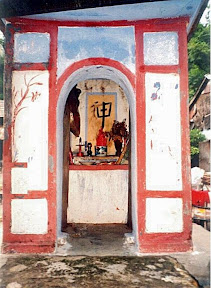
14/ THE TUTELARY GOD TEMPLE
Located at Moi Hamlet in Bai Lang Village, the Tutelary God temple is on a mountain slope facing the sea towards the west-northwest. The Tutelary God of the Cham Islands is a god who is worshipped by the local people. This God protects the people who are living and working in this area. According to the regulation of the former feudal court, The Tutelary God was worshipped in the communal house, and sacrificed by the national rituals. The temple is not large, but it has a unique architectural style on the Cham Islands. The roof is in the domed style. The gables are decorated with ceramics and animals.

Located at the residential area of Dinh Hamlet in Bai Lang Village, facing the sea, the temple worships the Ngu Hanh Fairy (Five Elements Fairy), one of the original religions closely connected to the “Mother” worshipping custom of the Vietnamese. The Five Elements Fairy is five goddesses: Metal, Wood, Water, Fire and Earth symbolizing the five basic elements of the universe following Oriental philosophy and having the important position in the system of traditional beliefs of the Vietnamese inhabitants. In the feudal period, these five goddesses were conferred titles and given fine names and sacrificed by the national rituals. On the Cham Islands, each village builds a Five Elements Temple for worshipping. Apart from the Five Elements Temple in Dinh Hamlet, there are others in Moi Hamlet, Cam Hamlet and Bai Huong Village.

The Vietnamese community settled on the Cham Islands in the 16th, 17th century. During the life process, they built many cultural, religious and civil constructions such as temples, pagodas, wells,… to meet living demands of the people. They also inherited, restored and renovated wells built by Champa people in the ancient time in accordance with their custom. The Cam Hamlet Well is at the residential area of Cam Hamlet. It is one of the ancient wells in the Champa style on the Cham Islands with 118 centimeters diameter, 4.5 meters in depth. Its interior was built with shaped collar and connected by traditional materials such as lime, bricks. At the bottom, there are four iron wood planks fixed a square. According historical documents, this was a place where international merchants stopped for commercial exchange such as food, water. Especially, the Cam Hamlet Well is well preserved until now and the local people still use it because the water resource is abundant, cool, clean and sweet. This relic was recognized as a National Relic by Ministry of Culture and Information on 13 December 2006 in accordance with Decision No.96/2006/QD-BVHTT.

17/ YEN CAVES (salagane caveS)
Yen Caves located on the island are the stone caves and the natural habitat of salangane. It is a special bird of Swiftlet genus with a scientific name of Yen Hang – Collocalia Fuciphaga Germaini Oustalet, belongs to Collocalia genus, Apodidac family, Apdiforme order. Their food is ants, termites, flies, may-bugs, dragonflies, spiders,… The birds make their nests with saliva secreted from two glands under their tongues. Therefore, salanganes nests (folk name: Yen sao) are considered a highly nutritious food (protein content from 36-52%). It is also a medicine used for the treatment of many diseases including tuberculosis, shinbone infection, anal infection, severe dysentery, acute asthma,… It is also precious goods with very high price. Yen caves are on the stony islands (folk name: Yen islands), mainly on Hon Kho, Hon Tai and Hon Lao (Cham Islands). The caves have mainly been created by crevices combined with falls in the granite, tens of meters in height. The direction of the crevices is usually northeast-southwest, northwest-southeast and rise vertically or tilt to one side with an angle 60-70 degrees, craggy access. Inside the caves, the walls are lonely with lapping waves at the bottom. The temperature in the caves is moderate, without the scorching southeast winds. Rain is quite rare and there is almost no mist.
The salagane caves on the Cham Islands are an unforgettably attractive landscape for each tourist visiting to the green Cham Islands.

18/ REVOLUTIONARY VESTIGES
When talking about the revolutionary vestiges of Cay Choi Cave, Hai Tang Pagoda, Mai Nha Cave, Mui Tho Temple (Hon Lao), Cay Dong Temple (Hon Dai), many people on the Cham Islands feel admiration, highly praise and pass on to later generations the images, names, and ages of revolutionary soldiers in “the special mission cell of Hoi An Town” because these places during 1966-1974 were where the revolutionary soldiers sheltered, exchange information about operations and to fight the enemy. The stories of revolutionary soldiers which circulated among the local people were about modest and very ordinary people but they had warm blood and boiling hearts for the love of their country, and a sentimental attachment to people and deep love of the nation. This was their motivation and will, irrespective of fatal risks and danger to their own lives by the enemies, they sacrificed their lives for the revolutionary cause because at that time, Hoi An was full of Americans, puppets and allied armies and under the strict control of coastal marine corps with support from the American Ranger Training Center with modern weapons based right at Bai Bim on the Cham Islands. The revolutionary soldiers in the beloved protecting hands of the people, often traveled up hill and down dale, passed over strong streams and dagerous seas or soaked under cliffs to bring the warm revolutionary sentiments to each local person on the Cham Islands and linked the people’s and enemies’ hearts with revolutionary forces. They complied with the Town Revolutionary Committee’s instructions for nonviolent operations in these places. They built bases to supply mainland bases, creating favourable conditions to attack large American and South Korean bases around Hoi An. Their deeds significantly contributed to the general comprehensive attack liberating all of South of Vietnam in 1975, mobilizing supporters to pursue and capture revolutionary reactionaries, establishing Army Administration Committee of Tan Hiep Hamlet, and properly seizing island area from the enemy and managing it.


19/ THE CHAM ISLANDS LANDSCAPES
Nature has endowed the Cham Islands with many valuable tourism properties. The terrain is mainly hills and mountains with abundant flora and many kinds of sea creatures. There are smooth and clean sandy beaches at pure sea water edge. Not far from the beach, abundant coral reefs and big rocks make a unique attraction. The slope at the eastern side of the island provides a grandiose landscape. At the foot of the cliffs is a deep abyss, where strong waves throw white foam, giving feelings to adventurous tourists. Particularly, in dangerous caves, nature has given the valuable salangane nests with their well-known nutrition.

20/ ISLANDS
There are seven large and small islands on the Cham Islands: Hon Lao, Hon Tai, Hon Dai, Hon Mo, Hon La, Hon Kho Me and Hon Nom. These islands range in a bow-shape. The biggest island is Hon Lao and the smallest island is Hon Kho Con. The total area of the island is over 15 square kilometers. The islands are mainly granite, schist and marble mountains. Hon Bien Mountain on Hon Lao has the highest peak of 517 meters. Opposite Hoi An town is Hon Lao. Its topography is convenient for people to live here. The most dangerous places are the isolated islands of Hon Tai, Hon Kho, home to the salanganes that give the nutritious nests with high economic value.

21/ BEACHES
Along the coast from the northwest to the southeast of Hòn Lao island, there are beaches such as: Bai Bac (4 small beaches), Bai Ong, Bai Lang, Bai Xep (3 small beaches), Bai Chong, Bai Bim, Bai Huong. They are in length from 100 meters (Bai Bac) to 700 meters (Bai Huong) and commonly 20 meters in width. Sloping gently with smooth and clean sand between rocks, they provide a diversity of strata and geomorphology. On Bai Bac and Bai Chong beaches are many big round-rocks which were naturally eroded or piled up to make deeply symbol images. On Bai Bac, there are many natural caves. Bai Ong, Bai Lang, Bai Huong beaches widen from 40 to 50 meters. Residents have exploited narrow areas to make terraced fields to plant rice and other food. Thanks to nature and man, there are many beautiful landscapes which are simple, natural and suggestive of the Cham Islands.
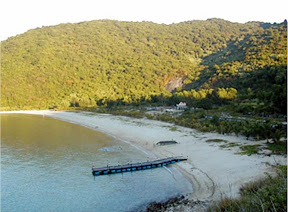
22/ TINH STREAM (LOVE STREAM)
Tinh Stream rises from the top of the mountains on Hon Lao, it saves its resource in the dry season, goes down strongly in the rain season, passed the falls and ended at residential area in Bai Lang Village – Cham Islands. From the immemorial time, it was a sweet, cool, clean resource and its water also was a worthy resource to the local people on the island. Besides, on the way to somewhere, it makes landscapes, interested places. This stream is a place where dated by couples of Cham Islands and surroundings, and it also embellishes folk-love stories until now. According to the oldest people here, this stream named Tinh Stream due to causes above. When we stand here to look the beach in the front of Bai Lang, we feel as though living in paradise. There is eroded stone with a hole like a diamond-shaped cradle in cool water, in this case if we have a bath in there, it is wonderful. Over there, there is a large even stone where we can lie to sunbathe and talk together. Coconut trees shade the whole area where cicadas chirp in the summer and birds make their nests in the winter. The famous Love Stream attracts tourists living on the mainland because the word “Love Stream” provokes everybody’s craving for love.
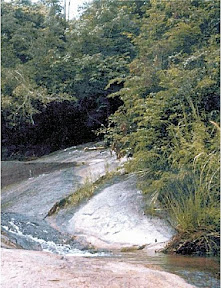
Source: Hoi An Center for Cultural Heritage Management and Preservation

